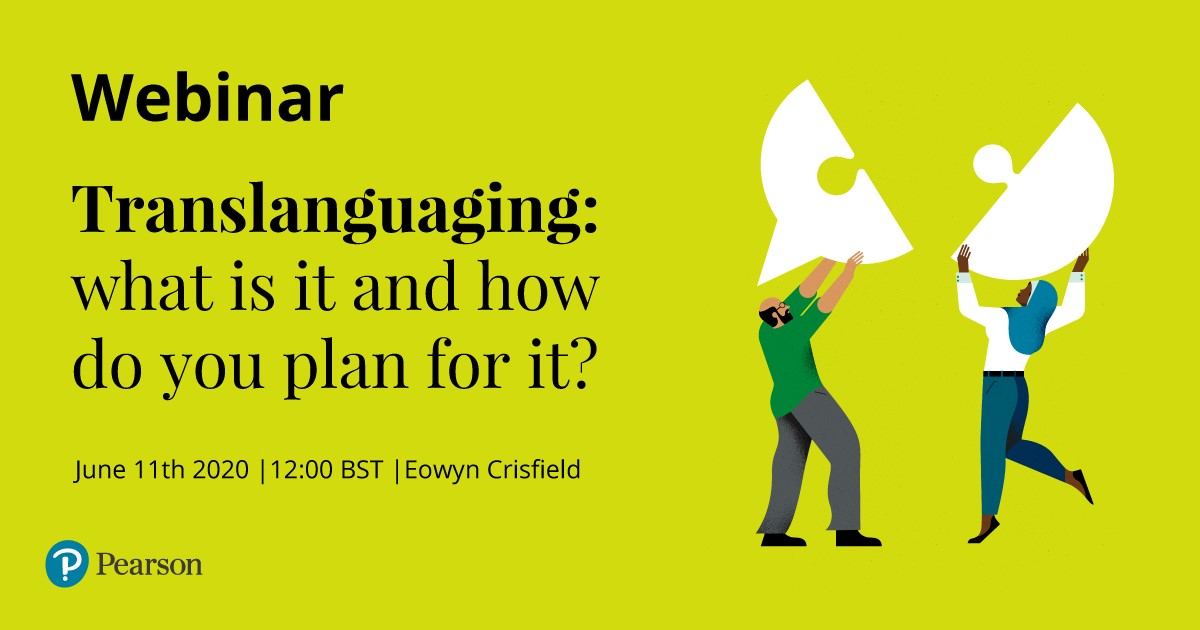
The term translanguaging has burst upon the applied linguistics and educational sector in the last years.
From modest origins as ‘trawsieithu’, the original Welsh word, used to describe a particular observed pedagogy, to the global phenomenon accompanied by conferences, journals, and no small amount of controversy, it can be hard to focus in on how it might be helpful when faced with a group of multilingual learners from diverse language backgrounds in a classroom.
While many of the pathways translanguaging has taken are interesting and important, in this post, as in all of my translanguaging work, I centre on the original Welsh characterisation.
Defining pedagogical translanguaging
In its original iteration, translanguaging was defined simply as the planned and systematic use of two languages within the same lesson, by specifying and varying the language of input and output.¹ In the observed settings, teachers were having students engage with content in one language (Welsh or English) as input for learning, and the output was planned to be in the other language. The pedagogical practice did not have any negative effects on language development or academic development, and indeed seemed to confer some benefits. This led to a growing interest in investigating how languages can function together for learning, rather than being kept separate, as was the general practice at the time. The idea of dynamic language use, rather than isolation, was, and remains to some extent, challenging to long-held notions about language acquisition and development.
Translanguaging in action
In the literature on translanguaging in the classroom, there are two different types that can be defined. The first is serendipitous, or unplanned, translanguaging. This type of translanguaging happens spontaneously in classrooms where linguistic diversity is valued and seen as a resource for learning. It can take the form of students translating/explaining to each other, the teacher doing the same, use of technology to allow for communication, and myriad other ways in which children will innovate with their languages to participate fully in the class learning and socialisation.
The second type is planned translanguaging, where the teacher makes considered decisions about the learning objectives, based on their understanding of the needs of their multilingual learners, and plans for language use accordingly. This type of translanguaging is where access to content can be made possible for new language learners, and where teachers can draw on students’ families, and prior knowledge to promote learning. It is also a method for enriching the curriculum in English-language schools which rely on mainly Western resources for learning. To develop this approach, we must consider a planning framework for implementation.
Creating a framework for implementation
Working from this original iteration, I have expanded the definition to include processing, which is an integral part of a learning cycle. Pedagogical translanguaging then becomes ‘the planned alternation of the languages of input, processing, and output in a learning cycle’. This definition allows for a clear framework for the planning of language alternation, and is key to teacher task design. Far from being a classroom linguistic free for all, which is something teachers often worry about, planned pedagogical translanguaging can be carefully planned and managed, even by a monolingual teacher.
Before any teacher can start implementing a translanguaging pedagogy, they first need to know the language profiles of their students, including:
- How well do they speak their home language(s)? Some children who have never lived in their ‘home’ country may actually not be very strong in their home languages, which makes it difficult to use them for learning.
- Do they have any literacy skills in their own language? Again, how you implement translanguaging varies immensely for students who are literate in their own language(s).
Once you have gathered this information, you are able to make productive decisions about how using home languages can be beneficial for different children in your class.
Planning for translanguaging
There are two simple questions that teachers can ask when applying a translanguaging lens to their teaching. This first is ‘Will this content be inaccessible for any of my learners because of their level of language?’
It’s important to remember that it takes students 5-9 years to develop full academic competency in a new school language, which means that this question will very often be affirmative. If indeed the answer is yes, then the teacher needs to determine what parts of the learning cycle will include home/dominant languages, to ensure that all students understand the content and can show their learning.
One might reasonably think that if all students are able to access the content through the school language that there would be no need for translanguaging. In fact, even when this is the case, there are many other reasons to integrate home languages into the learning cycle. If a class is doing a unit on ecosystems, having all students research an ecosystem from the country of their home language will enrich the learning of all the students, but bringing in a wider knowledge base and perspective.
The same could be said for any learning in humanities/social studies – the added value of having students research a topic from different perspectives, through the lens of information in different languages, can only have a positive impact on overall learning.
If you are interested in knowing more about pedagogical translanguaging, including sample task cycles, do watch our webinar.
Watch the webinar: Translanguaging: what is it and how do you plan for it?
Recorded Thursday 11 June 12:00 BST | Watch on demand
Want to learn more about translanguaging? In this webinar, Eowyn Crisfield, specialist in bilingualism in education and teacher-training, looks at a framework for translanguaging and specific planning strategies for implementation.
¹ Lewis, G., Jones, B., & Baker, C. (2012). Translanguaging: origins and development from school to street and beyond. Educational Research and Evaluation: An International Journal on Theory and Practice, 18(7), 641-654.
Further reading
Cenoz, J. (2017). Translanguaging in School Contexts: International Perspectives. Journal of Language, Identity & Education, 16(4), 193-198.
Cenoz, J., & Hunston, S. (Eds.). (2015). Multilingual Education: Between language learning and translanguaging. Cambridge: Cambridge University Press.
Duarte, J. (2015). Cross-linguistic transfer of academic language in multilingual adolescents. In H. Peukert (Ed.), Transfer Effects in Multilingual Language Development – Hamburg Studies on Linguistic Diversity (pp. 221-248). Amsterdam: John Benjamins Publishing Company.
Garcia, O., & Kleyn, T. (Eds.). (2016). Translanguaging with Multilingual Students. New York: Routledge.
Garcia, O., Ibarra Johnson, S., & Seltzer, K. (2017). The Translanguaging Classroom: Leveraging student bilingualism for learning. Philadelphia: Caslon.
Lewis, G., Jones, B., & Baker, C. (2012). Translanguaging:origins and development from school to street and beyond. Educational Research and Evaluation, 187, 641-654.
Paulsrud, B., Rosen, J., Straszer, B., & Wedin, A. (Eds.). (2017). New Perspectives on Translanguaging and Education. Bristol: Multilingual Matters.
Spiro, J., & Crisfield, E. (2018). Linguistic and Cultural Innovation in Schools: The Languages Challenge. London: Palgrave Macmillan.


